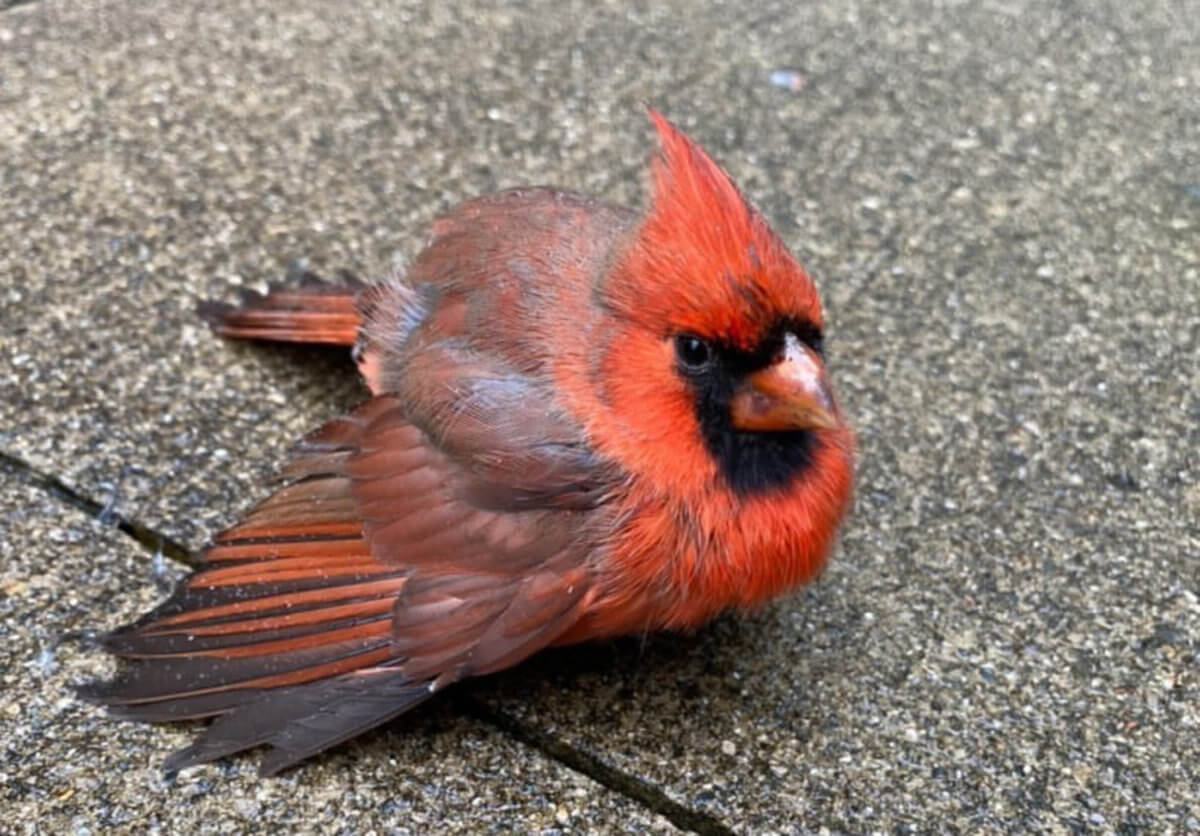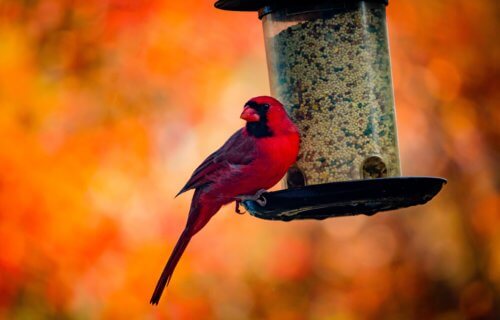LONDON, Ontario — Bird-watching becomes convenient when bird feeders lure them right up to our windows. Unfortunately for our feathered friends, birds often cannot detect a window in their path, causing them to fly straight into one — potentially killing them. You can still enjoy being up close and personal with your backyard birdies, but there are ways to help save them from possible injury. A new study reports that bird feeders should be placed within 18 inches of windows to prevent potentially fatal collisions.
“Given that birds’ flight velocity prior to impact predicts the lethality of collisions with windows, we recommend that bird attractants (feeders or baths) should be placed close to windows (within 1.5 feet or 0.5 m) to reduce the available space where birds can gain speed,” the researchers say.
Why birds fly into windows
Study co-author Brendon Samuels, a PhD candidate at Western University in Ontario, says that birds crashing into windows happens often all over the world. “But the frequency and severity of collisions seem to be underestimated by the public, especially at residential settings. One reason is that collisions happen suddenly and are difficult for people to observe directly. When birds fly away afterwards, it is unclear what ultimately happens to them,” he explains in a statement.
“Our findings highlight how common collisions can be in residential settings, especially where there are bird attractants like feeders,” he adds.
Along with their warming tunes and chirpy personalities, birds are a vital part of the ecosystem. However, these creatures are under threat. Windows reflect sky, clouds and trees. Millions of birds in the U.S. fly into windows each year, with around a third dying.
Audio and video recordings in a residential backyard now provide the first glimpse of what happens in the moments leading up to impact. An analysis of 29 collisions and nine near-misses showed flight velocity and angle of approach both predicted outcomes following a crash, authors of the study say.

Faster flights at angles of approach closer to perpendicular were most hazardous. Only a small proportion resulted in an immediate fatality and were detected by occupants. Most were followed by the bird flying away without leaving a trace. It is believed some may suffer injuries and later die far from the site.
This suggests the extent of collisions may be vastly underestimated by traditional survey methods. Surveys have focused mostly on larger structures such as office blocks. Yet residential buildings are the most numerous with windows. They represent the greatest cumulative threat.
New housing developments are being prioritized in many parts of the world. The appetite for large glass windows and railings continues to grow. Garden bird feeding has gained in popularity over the pandemic, drawing more birds into high-risk settings.
How to keep birds from potentially deadly collisions
The study shows that collisions occurred nearly as frequently with smaller windows as with large glass doors. “Given birds’ flight velocity prior to impact predicts the lethality of collisions with windows, we recommend bird feeders or baths should be placed within 1.5 feet to reduce the available space where birds can gain speed,” says Samuels.
New buildings can be designed based on practices that limit risk of bird-window collisions. Similarly, existing building windows, such as those on homes, can be retrofitted using simple materials to add visual markers to the exterior of the glass.
“An important direction for future research is to characterize how birds orient their eyes to detect and avoid collisions with windows, so collision deterrents can be designed optimally to match bird vision,” says Samuels. “This study documented birds approaching windows from variable angles. Designs and tests of collision prevention technologies should take this into account.”
The study is published in the journal PeerJ.
South West News Service writer Mark Waghorn contributed to this report.
Spanish version of this article: Su comedero podría estar enviando a nuestros amigos emplumados a la tumba

Your article contradicts itself. The opening paragraph states that feeders should NOT be placed within 18” of windows and then much later states that feeders SHOULD be placed within 1.5 feet of windows. The latter statement is correct, but sadly, the opening paragraph is what most people will read and they may never get to the correct information. Please edit the article or you are simply directing people to do what they should not do and thereby are contributing to the problem. Thank you.
When writing an article about a subject, you should ensure that you fully comprehend the content. This would save the embarrassment of offering advice in the beginning which is directly contradictory to the actual study being quoted at the end.
EDIT PLEASE: Please fix your first paragraph to say that they “should NOT” be placed further, beyond, or they should be “within 18 inches”, or placed “no further than” 18 in, to prevent high velocity collisions Etc.It is *incorrectly* written (showing edit) as “A new study reports that bird feeders should (strike: not) be placed within 18 inches of windows to prevent potentially fatal collisions.”
When I was in high school we had a walk bridge that went over a small Creek in between the two buildings at the high school. Because there was glass on both sides and there was a lot of trees around the birds used to think they could fly right through. The carnage underneath the windows was horrible. The school newspaper did an article and took pictures of all the birds under the windows. That led to the student council getting involved. On any given day you could walk down underneath the bridge and see 15 to 20 dead birds laying on the ground. The student council finally put big yellow dots on the windows. There were still some fatalities but not as many.
A better idea would be not to place the feeder directly in front of a window. Place them about 30 degrees off from the windows.
That reduced my impacts substantially. If a home owner has cats, the impact noise cues the cat in on a pilot down, and the body is often not recoverable.
I was able to rescue one disoriented pilot. I held if for a few minutes, and then set it on a branch next to the feeder. It slowly, over the course of an hour, began making sense of its surroundings, and eventually flew off, explained the incident to its flight wing, and I never had another impact after that last fall. The winter birds seem to have less impacts, and that may be due to the snow reflection from the ground. They also may be more intelligent, plan ahead and thus plan their flight paths more accurately with less flying by the seat of their pants.
Sentence 1 of paragragh 2 says the exact opposite of what is intended.
How so? 1.5 feet is 18 inches or is your comment about a different part?
🙂 After reading other comments, please disregard. 🙂
There’s a simple solution for home owners. They’re available on Amazon. Anti Bird Strike Electromagnetic Stickers to be applied on your windows. They also make it in a liquid pen. Since placing mine, Bird strikes have reduced by at least95%.
https://windowalert.com/?msclkid=573f050bc9281466e56566cd7e369dc2
Window Alert Ultra violet Anti Bird Strike decals and UV liquid.
I have my feeders, song bird feeders and finch feeders hanging from 8ft shepherd hooks in the middle of my yard…plus other things I put out in cat or dog dishes on the table like suet or berries..they also love to sit in my rose bushes…where I live kids love to shoot birds with bb g*ns… disgusting habit daddy taught them for practicing for bagging 40 quail or dove…I have a pair of kingbirds that make their nest on my telephone pole every year, I sit in my yard and they will come to eat and drink even when my dogs are out..
Great I found this to be interesting, some I didn’t know about bird and window
Silhouettes of birds can be purchased, probably through the Audubon Society or Duncraft, that you adhere to the windows near your feeders. These can be seen by the birds but are transparent for us indoors.
These signal to the birds that the window is there.